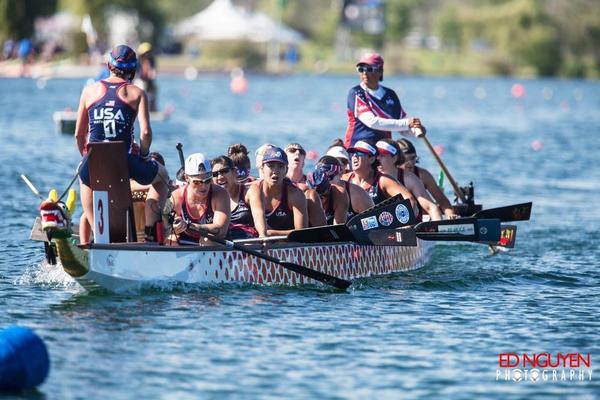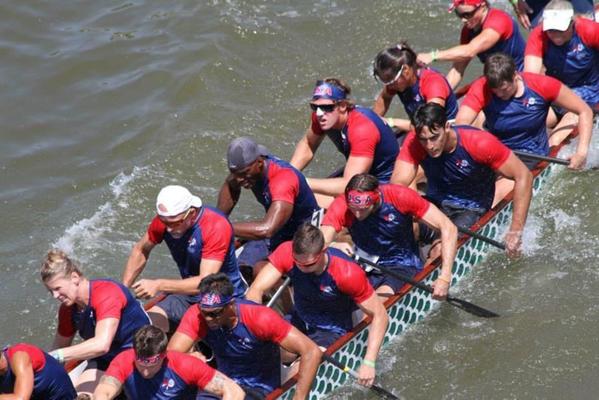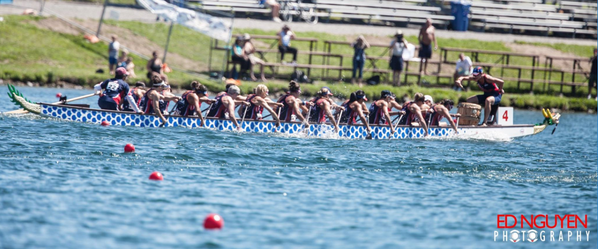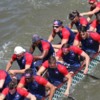By Megan Roberts, Community Engagement Program Manager at the Asthma and Allergy Foundation of America
I have had exercise-induced bronchoconstriction (asthma) for as long as I can remember. I have also been very active most of my life. Until the end of 2016, one didn’t really affect the other. Pretreating with albuterol before exercise managed all my asthma symptoms. In recent years, as my exercise habits have increased, I haven’t even carried an inhaler at times.
At the end of 2011, I found my way into a dragon boat, looking for a great full-body workout that was lower impact than running. Instantly, I was hooked. The workouts were intense, and I loved being on the water.
A dragon boat is a very long canoe that weighs around 600 pounds. There are 10 rows of paddlers, two per row. Each paddler works on one side for the duration of a race. A drummer barks direction and motivation from the front and a steerer guides the boat and ensures boat safety with a long oar from the back. Races are all sprint distance. The most common distance is 500 meters, which lasts anywhere from just under 2 minutes to closer to 3 for novice teams. But as a paddler it might as well last FOREVER. Boats race side by side in lanes, and often outcomes are determined by maddening tenths or hundredths of a second.
 The club team I coach and paddle for, the Schuylkill Dragons, competing at 2017 US Club Crew National Championships.
The club team I coach and paddle for, the Schuylkill Dragons, competing at 2017 US Club Crew National Championships.
In 2013, my second full season of competitive paddling, I tried out for and made the U.S. National Dragon Boat Team. Since then, I have competed as a member of the Premier Women’s and Mixed crews at world championships, traveling to Hungary and Canada, and medaling a dozen times (two golds). I’ve been fortunate to also compete around the world with my Philadelphia-based women’s dragon boat club, notably at club crew world championships in Ravenna, Italy; Montreal, Quebec; Ottawa, Ontario and Ponce, Puerto Rico. More recently I’ve been drawn to the excitement of racing long distances on bigger water and have assembled crews to compete in outrigger canoe races in the Gulf of Mexico, the Atlantic ocean and the Pacific ocean (Hawaii) so far. I am deeply grateful for all of these experiences, which have taken me to many parts of the world I’d never see otherwise, and introduced me to some wonderful souls along the way.
 2015 USA Premier Women gasping for breath after crossing the finish line of a 500-meter race in Welland, Canada. Photo credit: Ed Nguyen
2015 USA Premier Women gasping for breath after crossing the finish line of a 500-meter race in Welland, Canada. Photo credit: Ed Nguyen My first-ever race at Worlds: the Premier Mixed 2000-meter on the River Tisza in Hungary, 2013. I am the small person with red bandanna in the last seat behind a bunch of humongous men.
My first-ever race at Worlds: the Premier Mixed 2000-meter on the River Tisza in Hungary, 2013. I am the small person with red bandanna in the last seat behind a bunch of humongous men.

2015 USA Premier Women’s Team on the podium after our final race of the week, this time garnering silver in the 500 meter race. Photo credit: Ed Nguyen
In September 2016, I tried out again for the 2017 national team and was faster than ever. I was right on track to represent Team USA again October 18-22, 2017, in Kunming, China.
Then in October 2016, things abruptly changed. As the seasons transformed to crisp autumn, I was cramming in long runs, preparing for an upcoming half marathon in November. I suddenly found myself struggling to get anywhere close to my usual mile split pace, even though I knew I was in the best shape of my life. It didn’t make sense! Stubbornly, I pushed on. I ran the half marathon on a chilly fall morning with my inhaler in hand, overusing it and still falling short of my finish goal by several minutes. It was the last time I was able to run outside in the cold somewhat successfully.
Days later, I developed a respiratory infection, which impacted my ability to breathe normally during exercise for another month. I kept telling myself, “Just give yourself time. Your body will get back to normal soon.” But “normal” continued to elude me. Even my workouts in the warmth of the indoors following a lengthy warm-up were frustrating, and inevitably ended in disappointment. I didn’t connect the dots. Or maybe I was unwilling to. I was out of breath lifting weights, walking up stairs, carrying groceries into the house. It was frightening, but I didn’t want to admit I was struggling. Afterwards I’d feel sick for hours and sometimes exhausted for days. The albuterol I didn’t need before wasn’t even close to cutting it.
My persistence, in retrospect, was dangerously ignorant. But I was used to pushing through pain. My athletic success depended on it. Not only were things not improving, but I was making them worse. My chest muscles were constantly sore from struggling to pull in air. This persisted through to the spring, the beginning of my paddling season. My primary care provider placed me on oral steroids, which helped a bit, but not enough.
I started thinking hard about my ability to compete at a world championship-level event where I’d be racing up to six times a day for five days. There was a complicating factor, as well. Not only would I be pushing myself to my highest exertion level, which is a sure way to trigger asthma for me. This world championship would also be the most challenging this asthmatic has experienced to date: the race site is 6,100 feet above sea level.
This is higher than the city of Denver, Colorado – the place I first became painfully familiar with the term “altitude sickness.” It doesn’t affect everyone, but those who are can experience headaches, nausea, shortness of breath, fatigue, muscle weakness and other symptoms. Each breath carries a lower percent of oxygen than lower altitudes would. Exercise significantly increases the likelihood of altitude sickness and severity of symptoms.
Of course, the other athletes I'd be racing against would be facing some of the same challenges. How would I stack up with the additional challenge of asthma I could not even manage at sea level? Competing at a high altitude also seemed like an incredibly risky endeavor, considering I would not have regular access to medical care if something went wrong. What if I couldn’t manage my symptoms? What if I let my team down?
So, I decided to let my asthma win. I would sit out this world championship, get my symptoms under control and return in 2019. I set other goals for my season, which included completing the biggest outrigger race in the world, the Queen Lili’uokalani Canoe Race. The course follows 18 miles of gorgeous coastline along the Big Island of Hawaii. Training for distance, it turned out, was less triggering than sprint training. And although I thought I was finished with 2017 world championships, they were not finished with me!
In my next blog post, I’ll talk about the next steps in my road to Kunming, because it sure didn’t end when I thought it would. That was partially because I started working at the Asthma and Allergy Foundation of America.
Next: Breathing in the Boat: The Turnaround Point
 Megan Roberts is the Community Engagement Program Manager at the Asthma and Allergy Foundation of America. She manages exercised-induced bronchoconstriction and allergies, but still spends most of her free time paddling or as a dragon boat coach.
Megan Roberts is the Community Engagement Program Manager at the Asthma and Allergy Foundation of America. She manages exercised-induced bronchoconstriction and allergies, but still spends most of her free time paddling or as a dragon boat coach.








Comments (7)